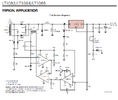jschatzman
New Member
How to replace an SCR pre-regulator with a MOSFET circuit?
The datasheet for the LT1083/4/5 linear voltage regulator includes a schematic for a 7.5A regulator with SCR pre-regulator. I want to modify the circuit so that:
a) It uses a bridge rectifier so as to be suitable for a toroidal input transformer (trivial).
b) It uses MOSFET switches instead of SCRs for improved efficiency.
Point (b) seems more of a challenge. TI and AD sell ideal rectifier chips that make it easy to replace the diodes in a standard bridge rectifier with MOSFETS. However, those chips aren't designed to provide voltage control through varying the duty cycle, as the SCR pre-regulator does.
Is there a published circuit for this? Or a different MOSFET driver chip that supports duty cycle control? Or..?
Yes I am aware that the "modern" way to do this is with a switching regulator. However, I am looking for a solution that produces essentially zero RF EMI in any form. The SCR pre-regulator produces low frequency switching noise on the input but this can be filtered out.
Thanks for any ideas!
The datasheet for the LT1083/4/5 linear voltage regulator includes a schematic for a 7.5A regulator with SCR pre-regulator. I want to modify the circuit so that:
a) It uses a bridge rectifier so as to be suitable for a toroidal input transformer (trivial).
b) It uses MOSFET switches instead of SCRs for improved efficiency.
Point (b) seems more of a challenge. TI and AD sell ideal rectifier chips that make it easy to replace the diodes in a standard bridge rectifier with MOSFETS. However, those chips aren't designed to provide voltage control through varying the duty cycle, as the SCR pre-regulator does.
Is there a published circuit for this? Or a different MOSFET driver chip that supports duty cycle control? Or..?
Yes I am aware that the "modern" way to do this is with a switching regulator. However, I am looking for a solution that produces essentially zero RF EMI in any form. The SCR pre-regulator produces low frequency switching noise on the input but this can be filtered out.
Thanks for any ideas!

